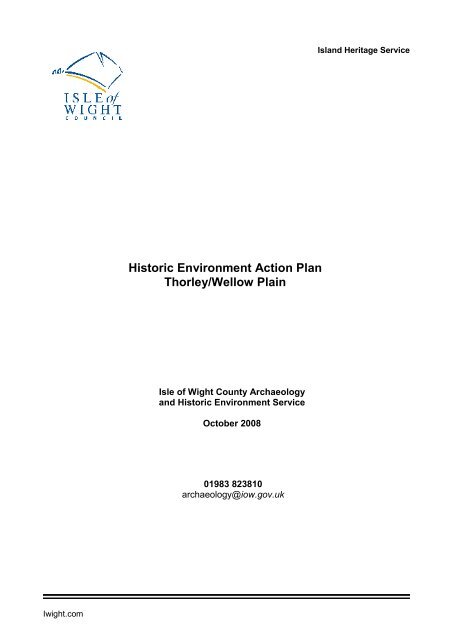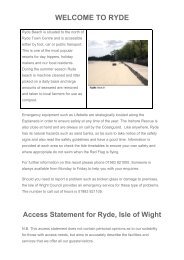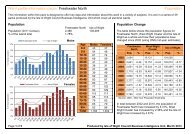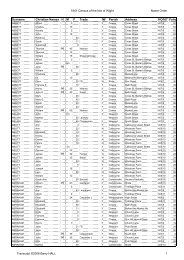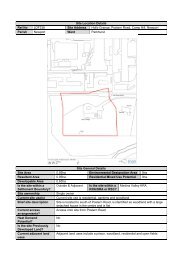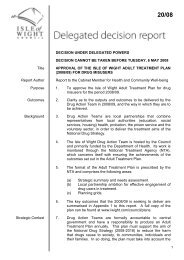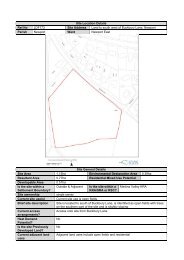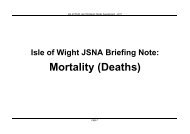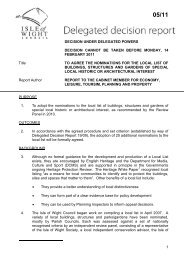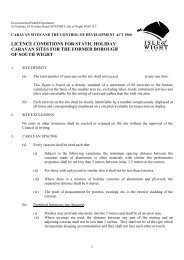Thorley Wellow Plain HEAP - Isle of Wight Council
Thorley Wellow Plain HEAP - Isle of Wight Council
Thorley Wellow Plain HEAP - Isle of Wight Council
- No tags were found...
Create successful ePaper yourself
Turn your PDF publications into a flip-book with our unique Google optimized e-Paper software.
Island Heritage ServiceHistoric Environment Action Plan<strong>Thorley</strong>/<strong>Wellow</strong> <strong>Plain</strong><strong>Isle</strong> <strong>of</strong> <strong>Wight</strong> County Archaeologyand Historic Environment ServiceOctober 200801983 823810archaeology@iow.gov.ukIwight.com
<strong>HEAP</strong> for <strong>Thorley</strong>/<strong>Wellow</strong> <strong>Plain</strong>INTRODUCTIONThe <strong>Thorley</strong>/<strong>Wellow</strong> <strong>Plain</strong> has been defined on the basis <strong>of</strong> its geology, topography and historicsettlement patterns but also on the basis <strong>of</strong> its distinctive present-day character as an open andexposed landscape with few field boundaries or hedgerows.This exposed character, particularly in the central part <strong>of</strong> the <strong>HEAP</strong> Area, justifies the use <strong>of</strong> theterm <strong>Plain</strong> in naming this Area, but the term is not entirely accurate as even the central part <strong>of</strong> thisArea is on a gentle slope and is dissected by streams which provide some variation in relief.This document identifies the essential features <strong>of</strong> the <strong>Thorley</strong>/<strong>Wellow</strong> <strong>Plain</strong> as a rural farmedlandscape with historic linear settlements at <strong>Thorley</strong> and <strong>Wellow</strong>. Buried archaeological featuresand archaeological finds recovered from the plough soil are identified as being <strong>of</strong> specialsignificance within this Area. The document also identifies the most significant features <strong>of</strong> thehistoric landscape and considers the most important forces for change. Management issues arediscussed and actions particularly relevant to this Area are identified from those listed in the <strong>Isle</strong> <strong>of</strong><strong>Wight</strong> <strong>HEAP</strong> Aims, Objectives and Actions.ANALYSIS AND ASSESSMENTLocation, Geology and Topography• This <strong>HEAP</strong> Area is bounded by the River Yar in the west, <strong>Thorley</strong> Brook in the north, theCalbourne-Brighstone Road (Lynch Lane) in the east and the West <strong>Wight</strong> Chalk Downlandin the south.• In the central part <strong>of</strong> this Area, to the south <strong>of</strong> <strong>Thorley</strong> and <strong>Wellow</strong>, there are deposits <strong>of</strong>Bembridge Limestone surrounded by Osborne and Headon Beds and Bracklesham Groupdeposits.o Narrow deposits <strong>of</strong> London Clay and Reading Beds lie between the Bracklesham GroupBeds and the West <strong>Wight</strong> Chalk Downland.o Bembridge Marls lie to the north <strong>of</strong> the Bembridge Limestone.• The Bembridge Limestone deposit within this Area is the only extensive outcrop <strong>of</strong> thedeposit on the Island away from the coast.o However, until the early 20 th century the limestone in this Area appears not to haveobeen quarried, possibly because it is not <strong>of</strong> a quality suitable for building stone.Soils derived from the Bembridge Limestone in this Area are easily worked, welldrainedloams.• The <strong>Thorley</strong>/<strong>Wellow</strong> <strong>Plain</strong> has an altitude <strong>of</strong> 105m OD at the foot <strong>of</strong> the chalk ridge, fallingto 80m OD near Freshwater-Calbourne Road and then sloping down gently to 5m OD at<strong>Thorley</strong> Manor.oThe relief in the eastern part <strong>of</strong> Area between Dodpits Lane and Lynch Lane is morevaried.• Barnfield Stream flows north-west into Yar Estuary.• <strong>Thorley</strong> Brook derives from streams rising near the B3401 and flowing north to <strong>Wellow</strong>. Thebrook itself flows west past <strong>Thorley</strong> and leaves this <strong>HEAP</strong> Area to the north <strong>of</strong> <strong>Thorley</strong>Manor.• In the eastern part <strong>of</strong> this <strong>HEAP</strong> Area a stream rises below Chessell Down and flows northeastpast Little Chessell and Chessell Copse to enter the Caulbourne Stream at Newbridge.Defining Attributes and Principal <strong>HEAP</strong> Types• Main settlements are <strong>Thorley</strong> and <strong>Wellow</strong>, strung out along the B3401.o There are also several historic manor houses and a few other farmhouses anddwellings <strong>of</strong> more recent origin.• Entirely rural Area with nearly all land in agricultural use.• A generally open and exposed landscape with large prairie fields and few hedgerows.1Iwight.com
o 64% (by area) <strong>of</strong> the field patterns within the <strong>Thorley</strong> <strong>Wellow</strong> <strong>Plain</strong> are made up <strong>of</strong> largefields (over 12 hectares).o The <strong>Thorley</strong>/<strong>Wellow</strong> Area has a higher percentage <strong>of</strong> large fields than any other <strong>HEAP</strong>Area except the Atherfield Coastal <strong>Plain</strong>. (Large fields make up approximately 21% <strong>of</strong>field patterns within the Island as a whole).• Most land is in arable use but there is dairy farming on improved grassland to the north <strong>of</strong>East Afton Farm and Tapnell Farm.o There are also small valley-floor pasture fields between the settlement <strong>of</strong> <strong>Thorley</strong> and<strong>Thorley</strong> Brook.• Between River Yar and Wilmingham Road there is ancient woodland at Backet’s Copseand <strong>Thorley</strong> Copse, a replanted ancient woodland at Mill Copse and a small amount <strong>of</strong>secondary woodland and plantation woodland.o Between Wilmingham Road and Broad Lane there are larger blocks <strong>of</strong> plantationwoodland with pockets <strong>of</strong> replanted ancient woodland centred around WilminghamPlantation and Tapnell Furse.o Between Broad Lane and Dodpits Lane there is virtually no woodland apart from thetiny areas <strong>of</strong> Hummet Copse and Stony Copse beside minor streams.o Between Dodpits Lane and Lynch Lane there is valley floor woodland at ChessellCopse and a number <strong>of</strong> small copses associated with the designed landscape <strong>of</strong>Westover.• At the northern edge <strong>of</strong> this Area the B3401 runs from <strong>Thorley</strong> Manor to the east <strong>of</strong> <strong>Wellow</strong>.o <strong>Wellow</strong> Top Road runs from <strong>Wellow</strong> village to Dodpits Lane.o At the southern edge <strong>of</strong> this Area the B3399 runs from Afton in the west to Chessell inthe east.o Wilmingham Road and Dodpits Lane cross this Area from north to southo Broad Lane runs diagonally across the Area from <strong>Thorley</strong> to Shalcombe and the B3401also runs diagonally across the Area from Chessell to Sweetwater Copse (south <strong>of</strong>Calbourne Mill).• Rights <strong>of</strong> way are significantly less dense within this Area than in some other <strong>HEAP</strong> Areas,(particularly downland edge areas)ooFrom River Yar to Wilmingham Road rights <strong>of</strong> way run from west to east.From Broad Lane to Dodpits Lane three rights <strong>of</strong> way run from north to south (includingthe Hamstead Trail) and play a part in defining the ‘grain’ <strong>of</strong> the landscape.Principal Historical Processes• An abundance <strong>of</strong> archaeological cropmarks within this Area suggests tree clearance,occupation and agriculture from Late Neolithic /Early Bronze Age (O’Rourke 2006).o This contrasts with the relative lack <strong>of</strong> evidence for prehistoric settlement in theadjacent Northern Lowlands <strong>HEAP</strong> Area, where tree clearance continued into themedieval period.• Concentrations <strong>of</strong> Roman and early Anglo-Saxon material indicate probable occupationsites although no major settlements have been identified.o The quantity and richness <strong>of</strong> pagan Anglo-Saxon finds from within this Area iscomparable to that <strong>of</strong> finds from the nationally important Chessell Cemetery (within theWest <strong>Wight</strong> Downland Area).• In the 11 th century, just before the Norman Conquest, <strong>Thorley</strong> formed part <strong>of</strong> a large estateheld by Earl Tostig and centred on Kings Manor, Freshwater.• Only a small part <strong>of</strong> the medieval Calbourne Estate (which belonged to the bishopric <strong>of</strong>Winchester from the 10 th century until the late 13 th century) lay within this <strong>HEAP</strong>Area.• Domesday Book records manors within this Area at Afton, Wilmingham, <strong>Thorley</strong>, <strong>Wellow</strong>and Shalcombe.ooAfton and Wilmingham lay within the medieval parish <strong>of</strong> Freshwater.<strong>Thorley</strong> Manor lay within <strong>Thorley</strong> Parish after this parish had been taken out <strong>of</strong> eitherFreshwater Parish or Shalfleet Parish by the 12 th century.2Iwight.com
ooo<strong>Wellow</strong> Manor lay within Shalfleet Parish.Chessell (not recorded in Domesday Book) was part <strong>of</strong> the Manor <strong>of</strong> Shalfleet until theearly 14 th century when it became an independent manor.Shalcombe Manor was one <strong>of</strong> the disparate parcels <strong>of</strong> land attached to the Chapel <strong>of</strong> StNicholas at Carisbrooke Castle; all <strong>of</strong> these land parcels being within the notionalParish <strong>of</strong> St Nicholas. The manor became a grange <strong>of</strong> Quarr Abbey at an unknown date(Hockey 1970, 84), probably after 1284 (Page ed. 1912, 274).• This <strong>HEAP</strong> Area includes nearly all <strong>of</strong> the medieval <strong>Thorley</strong> Parish and parts <strong>of</strong> themedieval parishes <strong>of</strong> Freshwater, Shalfleet, Calbourne and St Nicholas.• The OS 1793 map shows interrupted-row settlements at <strong>Thorley</strong> Street and <strong>Wellow</strong>, eachsettlement comprising a number <strong>of</strong> farmsteads. Margham (1990) has suggested settlementshift from <strong>Thorley</strong> Manor to <strong>Thorley</strong> Street by mid 16 th century.o A footpath (Y5) north <strong>of</strong> the present B3401 was the original route between <strong>Thorley</strong>Manor and <strong>Thorley</strong> Street.o The original parish church next to <strong>Thorley</strong> Manor was demolished (except for the porch)and replaced by a new church at <strong>Thorley</strong> Street in 1871.• <strong>Wellow</strong> Manor, within the medieval Shalfleet Parish, was in the same ownership as <strong>Thorley</strong>Manor from 1337 to 1478 (Page ed. 1912, 274).o <strong>Wellow</strong> Farm (probably on the site <strong>of</strong> the original manor house) is situated close to<strong>Thorley</strong> Brook beside <strong>Wellow</strong> Top Road.o <strong>Wellow</strong> Top Road lies south <strong>of</strong> the B3401 and runs parallel to it. The OS 1793 mapshows small plots <strong>of</strong> grazing land with boundaries running between the two roads andwidely spaced farmsteads spread out along the road that is now the B3401.oThis regular layout <strong>of</strong> small grazing plots with straight boundaries running at rightangles between the two roads raises the possibility that <strong>Wellow</strong> originated as a plannedvillage and then suffered from late medieval depopulation.o However, a more likely explanation is that the two roads originally enclosed arectangular green, around which the settlement developed.o The name ‘<strong>Wellow</strong>green’ appears on the OS 1 st Edition 6" map <strong>of</strong> 1866 at the westernend <strong>of</strong> the settlement.o Several farmsteads and cottages are also shown on the OS 1793 map beside theB3401 to the west <strong>of</strong> the village. Buildings in this position today include Marshfield andMattingley Farm on either side <strong>of</strong> a 19 th century Baptist chapel.• These case studies <strong>of</strong> <strong>Thorley</strong> and <strong>Wellow</strong> raise the wider question <strong>of</strong> medievaldepopulation and settlement desertion on the <strong>Isle</strong> <strong>of</strong> <strong>Wight</strong>.o Beresford (1954) and Beresford and Hurst (1971) identified 32 <strong>Isle</strong> <strong>of</strong> <strong>Wight</strong> settlementsthought to have been depopulated in medieval times. However, the medieval taxationrecords studied by Beresford and Hurst refer to administrative areas rather thanindividual settlements, although they certainly suggest population decline in the 14 thcentury.oA manorial hamlet may possibly have been associated with Afton Manor, although by1793 the only buildings fairly close to the manor house were Afton Mill and Afton Farm.• Today the only buildings on medieval sites away from the settlements <strong>of</strong> <strong>Thorley</strong> and<strong>Wellow</strong> appear to be the manor houses <strong>of</strong> Afton, Chessell and Shalcombe.However, the place-name ‘Churchills is mentioned in a document <strong>of</strong> 1295 (Kökritz 1940,209) and a farm is shown here on the OS 1793 map.• The lack <strong>of</strong> small settlement clusters dotted about within the present agricultural landscapecontrasts with the polyfocal settlement pattern <strong>of</strong> Freshwater <strong>Isle</strong>.• Settlements at <strong>Thorley</strong> and <strong>Wellow</strong> developed close to the <strong>Thorley</strong> Brook at the interfacebetween the free-draining soils on Bembridge Limestone to the south and the narrow strip<strong>of</strong> damp pasture beside <strong>Thorley</strong> Brook.o The OS 1793 map shows this strip <strong>of</strong> land divided into small pasture fields or meadowsfrom Ningwood Manor Farm in the east (just outside this Area) to <strong>Thorley</strong> Manor in thewest.o In medieval times this land may have served as common meadow.3Iwight.com
• It was alleged by Worsley (1781, 264) that ‘the greater part <strong>of</strong> <strong>Thorley</strong> was once a rabbitwarren, as appears by a grant <strong>of</strong> the Countess Isabella’. This statement refers to a period inthe later 13 th century but it seems questionable whether the rabbit warren was as extensiveas Worsley suggested.o The location <strong>of</strong> the warren is unknown. It could have been on <strong>Thorley</strong> Common butTapnell Furze is a more likely site (see below).• Medieval open-fields are recorded within the manors <strong>of</strong> <strong>Thorley</strong> and <strong>Wellow</strong>.o In <strong>Thorley</strong> Manor the open-field may have been to the south <strong>of</strong> <strong>Thorley</strong> Street and tothe south and west <strong>of</strong> <strong>Thorley</strong> Manor House.o A manorial survey <strong>of</strong> <strong>Thorley</strong> in 1648 refers to ‘Westfield’, ‘Homefield’ and ‘East Field’but by 1608 these open fields appear to have been enclosed (Margham 1990).o The OS 1793 map shows that the land to the south and west <strong>of</strong> <strong>Thorley</strong> Manor Housewas enclosed into relatively large fields whereas the land to the south <strong>of</strong> <strong>Thorley</strong> Streetwas enclosed into small strips.o A survey <strong>of</strong> 1608 refers to ‘West Field’ and ‘East Field’ within <strong>Wellow</strong> Manor. At thisdate about half the land <strong>of</strong> <strong>Wellow</strong> Manor was still held as unenclosed strips althoughthe demesne land was enclosed.o Part <strong>of</strong> <strong>Wellow</strong> Manor’s open-field was still unenclosed in 1793 when the OS mapshows a large ‘L’ shaped block <strong>of</strong> land surrounded by small fields.o The names ‘West Field Arable’ and ‘Part <strong>of</strong> West Common Field’, shown within thisblock <strong>of</strong> land on the Shalfleet Tithe Map <strong>of</strong> 1840 indicate that <strong>Wellow</strong>’s open fields hadbeen in this area.oThe present-day ‘Hamstead Trail’ is shown on the OS 1793 map as a road runningalong the east side <strong>of</strong> <strong>Wellow</strong>’s unenclosed open-field land and <strong>Wellow</strong> Common• Historic maps suggest the former presence <strong>of</strong> open-field elsewhere within this <strong>HEAP</strong> Areaat Wilmingham and to the south <strong>of</strong> Afton Manor (Margham 1992, 110).• A survey <strong>of</strong> <strong>Thorley</strong> Manor in1648 listed only 156 acres <strong>of</strong> arable land out <strong>of</strong> a total holding<strong>of</strong> 1580 acres.oThis is quite surprising as at least half <strong>of</strong> the manor lies on Bembridge Limestone, much<strong>of</strong> which is now used for arable agriculture, although the land around Tapnell Farm isstill used for grazing.• 657 acres <strong>of</strong> unenclosed land was recorded within <strong>Thorley</strong> Manor in the 1648 survey andmuch <strong>of</strong> this was within this <strong>HEAP</strong> Area although it also included common downland in theWest <strong>Wight</strong> Chalk Downland Area.ooThe unenclosed land would have included the rough land <strong>of</strong> Tapnell Furze to thenorthwest <strong>of</strong> Tapnell Farm.The remainder <strong>of</strong> the unenclosed land must have been on <strong>Thorley</strong> Common which layon the eastern side <strong>of</strong> the parish and abutted <strong>Wellow</strong> Common.• There was common for 616 sheep within <strong>Thorley</strong> Manor in 1608. Within <strong>Wellow</strong> Manor atthe same date there was common for 300 sheep belonging to the demesne land and 420sheep belonging to manorial tenants.oo<strong>Wellow</strong> Manor, like <strong>Thorley</strong> Manor, had common downland grazing in the West <strong>Wight</strong>Chalk Downland Area, in addition to that available on <strong>Wellow</strong> CommonIt could be inferred that sheep farming was significant in the early post-medieval periodbut the tenants <strong>of</strong> Kings Manor in Freshwater Parish had a greater number <strong>of</strong> sheep,despite the fact that a considerable portion <strong>of</strong> King Manor was arable open-field.• <strong>Thorley</strong> Common and <strong>Wellow</strong> Common lay together to the south <strong>of</strong> the open fields <strong>of</strong><strong>Thorley</strong> and <strong>Wellow</strong>, mainly on the relatively good quality land <strong>of</strong> the Bembridge Limestone.o The western edge <strong>of</strong> <strong>Thorley</strong> Common was in line with the present-day footpath Y9.ooThe area <strong>of</strong> <strong>Thorley</strong> Common and <strong>Wellow</strong> Common ran from the junction <strong>of</strong> Broad Laneand footpath Y9 in the west to the Hamstead Trail (bridleway S19) in the east.<strong>Thorley</strong>/<strong>Wellow</strong> Common had been enclosed by 1793. The OS map <strong>of</strong> this date showsBroad Lane cutting across small plots with straight boundaries but before enclosureBroad Lane would have been an unfenced track across the open common.4Iwight.com
o The boundary between <strong>Wellow</strong>’s open-field and <strong>Wellow</strong> Common is defined in themodern landscape by footpath S34.o The present-day ‘Hamstead Trail’ defines the eastern edge <strong>of</strong> <strong>Wellow</strong> Common.o The southern boundary <strong>of</strong> <strong>Wellow</strong> Common ran along the B3399.• Regular fields with a north-south axis between the chalk ridge and the B3399 wereprobably enclosed from downland-edge common in the 17 th or 18 th century.• Tapnell Farm is first mentioned as Tapwell Farm in 1715 and appears to be a postmedievalholding associated with the reclamation <strong>of</strong> rough ground, possibly including thelower slope <strong>of</strong> Tapnell Down but also land in the area <strong>of</strong> the present Tapnell Furze forestryplantation.o Tapnell Furze appears to have been a mosaic <strong>of</strong> wet and dry rough grazing land andscrub until reclamation took place and may have been the site <strong>of</strong> <strong>Thorley</strong>’s medievalrabbit warren (see above).o Dog Kennel Cottage, on the west side <strong>of</strong> Broad Lane, is <strong>of</strong> 18 th century date and mayhave been built as a squatter’s cottage on the edge <strong>of</strong> Tapnell Furze.o By 1793 Tapnell Furze had been enclosed into fairly large irregular fields (mainly usedfor grazing) but much <strong>of</strong> it is shown as rough ground on the 1866 6 inch OS map.• East Afton Farm (within Freshwater Parish) is not shown on the OS 1793 map although asmall unnamed building is shown nearby. The farm is first named and shown in its presentposition on the Freshwater Tithe Map <strong>of</strong> 1839.o This new farmstead may have been responsible for the enclosure <strong>of</strong> land to the north <strong>of</strong>the farmstead, including a large close named ‘North Park’ on the tithe map.o North Park, including the tiny area <strong>of</strong> surviving ancient woodland at North Park Copse,may have been the site <strong>of</strong> the medieval rabbit warren at Afton Manor mentioned in 1343(Margham 1992, 112-113).• The origins <strong>of</strong> the field patterns at the eastern end <strong>of</strong> this Area between Dodpits Lane andLynch Lane are uncertain.o The field patterns shown on the OS 1793 map seem to suggest an original enclosurepattern <strong>of</strong> large closes with a predominantly north-south axis which were subdivided ata later date.oA tentative 16 th or early 17 th century date for these large closes may be suggested byanalogy with other <strong>Isle</strong> <strong>of</strong> <strong>Wight</strong> examples (e,g, on the Swainston estate to the east <strong>of</strong>Newtown and on the lands <strong>of</strong> St Helens Priory).• By 1862 the land between Broad Lane and Dodpits Lane was divided into semi-regularfields <strong>of</strong> small-medium size (3-6 hectares), retaining some field boundaries relating toearlier enclosure patterns and influenced by the natural drainage pattern.• About 66% <strong>of</strong> <strong>Thorley</strong> Parish was arable land by 1844, compared with about 10% in 1648(Margham 1990, 124).• A landscape park was created at Westover from the late 18 th century.oThe inner park falls within the Northern Lowlands Area. However, the wider designedlandscape to the south <strong>of</strong> the park lies mainly within this <strong>HEAP</strong> Area and partly withinthe area designated on the English Heritage Register (see Conservation Designations).o Westover Farm, Westover Park Farm and Wheelbarrow Cottage (an ornamental estatelodge) all lie to the south-west <strong>of</strong> the park within the designed landscape.o Westover Farm is shown but not named on the OS 1793 map. It may possibly equatewith ‘Woodcotts or Westover Hawley’, named in a lease <strong>of</strong> 1429 (BL Add.Ch.56584).o The OS 1793 map shows only a barn in the position <strong>of</strong> Westover Park Farm and thisfarmstead was clearly subsidiary to Westover Farm even in the 19 th century, although asmall cottage and more elaborate farm buildings are shown on 19 th century OS mapsfrom 1862.• Between 1793 and 1862 a number <strong>of</strong> small copses and rews had been created within theWestover designed landscape and existing copses had been modified.o This woodland cover was probably planted for the purposes <strong>of</strong> hunting or thepreservation <strong>of</strong> game.5Iwight.com
o Page (1912, 218) states that Westover House was built in the 18 th century as a huntingboxby Leonard Troughear Holmes.o <strong>Isle</strong> <strong>of</strong> <strong>Wight</strong> hunts chased hares until 1845, when foxes were first introduced inquantity. At least three packs <strong>of</strong> harriers for hare-hunting existed by 1820 (Phillips2008).• A second landscape park within this <strong>HEAP</strong> Area was developed around Afton Manor in the19 th century.• Prospect Cottage had been built by 1862 on a plot <strong>of</strong> land lying on the former <strong>Wellow</strong>Common.• Prospect Quarry lies to the north <strong>of</strong> Prospect Cottage beside Broad Lane, also on land thatwas formerly within <strong>Wellow</strong> Common.o The quarry appears to have been exploited only from the early 20 th centuryo The quarried material is classified as ‘weak limestone’ and at present the quarry is onlyoworked intermittently for use as infill (e.g. in gabion baskets).Prospect Quarry is the only Bembridge Limestone Quarry still being worked on the <strong>Isle</strong><strong>of</strong> <strong>Wight</strong>.• Forestry Commission plantations were established at Tapnell Furze, mainly from 1940to1960.• The landscape character <strong>of</strong> the <strong>Thorley</strong>/<strong>Wellow</strong> <strong>Plain</strong> Area changed very considerably inthe later 20 th century as a result <strong>of</strong> hedgerow removal, creating much larger fields than inmost other parts <strong>of</strong> the Island.• Ponds to the north <strong>of</strong> Churchills Farm appear to have been created in the late 20 th century.• The settlement character <strong>of</strong> <strong>Thorley</strong> and <strong>Wellow</strong> was modified in the later 20 th century byinfilling between plots, many <strong>of</strong> the new buildings being bungalows.• An application for a wind farm within this Area was submitted in 2006 but did not receiveplanning approval.Archaeology and Built Environment (for details see HER)• Aerial photographs have revealed at least ten ring-ditches <strong>of</strong> probable Bronze Age dateclose to <strong>Wellow</strong> Farm and a number to the south <strong>of</strong> <strong>Thorley</strong> Street. Many more arecurrently listed in the HER as <strong>of</strong> ‘unknown date’.oOne ring-ditch partially excavated in 1984 was thought to be a ploughed Bronze Ageround barrow. Romano-British material was found in the adjacent plough soil.• Aerial photographs also provide evidence <strong>of</strong> many sub-rectangular enclosures (to the east<strong>of</strong> Dog Kennel Cottage and close to Hummet Copse) and <strong>of</strong> many linear features.• Field-walking in the 1980s revealed a wide distribution <strong>of</strong> prehistoric flintwork and Romano-British ceramics (Margham 1990, 116).• More recently an archaeological watching brief prior to the insertion <strong>of</strong> a pipeline inconnection with Seaclean <strong>Wight</strong> revealed four main sites (O’Rourke 2006, 4.26):ooooSite to east <strong>of</strong> Wilmingham Lane produced Iron Age pottery and features includingsome 12 postholes, pits and a gully.To the south <strong>of</strong> <strong>Thorley</strong> a hearth and two pits were located and tentatively associatedwith a nearby ploughed ring barrow. Another pit produced pottery sherds <strong>of</strong> Romano-British and medieval date. A section <strong>of</strong> trackway and field boundary may have beenassociated with medieval agricultural activity.Immediately to the west <strong>of</strong> Broad Lane and south <strong>of</strong> <strong>Thorley</strong> village a scatter <strong>of</strong>medieval pottery was located. This was thought to have been spread as a result <strong>of</strong>manuring practices. Several flint artefacts <strong>of</strong> Mesolithic, Neolithic and Bronze Age datewere also recovered.At <strong>Wellow</strong> village medieval and post-medieval features were uncovered, including fieldboundaries, drainage ditches and gullies, a hearth, a trackway and deep deposits <strong>of</strong>medieval plough soils, These deep plough soils sealed a large amount <strong>of</strong> prehistoricflint and datable earlier medieval activity on the site and also a possible prehistoric pit orcremation cut associated with a ring ditch.6Iwight.com
• Recent finds from the plough soil have included a Roman coin hoard, evidence for Romanoccupation, rich concentrations <strong>of</strong> 6 th century Anglo-Saxon metalwork and other finds.These have been recorded under the Portable Antiquities Scheme and some can beviewed on the Scheme’s website www.finds.org.ukooThe finds have been made in four main locations within this <strong>HEAP</strong> Area.One <strong>of</strong> these locations has produced a copper-alloy Early Christian skillet thought to bea baptismal vessel dating from the 7 th or 8 th century A.D. (Basford 2007, 204).• Only surviving remnant <strong>of</strong> <strong>Thorley</strong>’s medieval parish church is its porch, situated close to<strong>Thorley</strong> Manor, with replacement 19 th century church some distance to east at <strong>Thorley</strong>Street.• The manor houses at Shalfleet and Shalcombe date from the 17 th century and those at<strong>Thorley</strong> and Afton from the early 18 th century.o Chessell Manor House and <strong>Wellow</strong> Farm are also <strong>of</strong> 18 th century date.• Farmhouses, farm buildings and cottages are built <strong>of</strong> Bembridge Limestone or <strong>of</strong> brick.o Distinctive 19 th century buildings at <strong>Wellow</strong> include the Literary Institute and the BaptistChapel.Relationships with other <strong>HEAP</strong> Areas• All the manors <strong>of</strong> this <strong>HEAP</strong> Area held portions <strong>of</strong> the West <strong>Wight</strong> Downland chalk ridge ascommon grazing land. Drove tracks linked the <strong>Thorley</strong>/ <strong>Wellow</strong> <strong>Plain</strong> and the chalk ridge.These are preserved in the modern landscape as rights <strong>of</strong> way F31, F27/28, S19 (theHamstead Trail) and the southern part <strong>of</strong> S21.Time-Depth• Evidence from air photographs <strong>of</strong> buried prehistoric features.• Significant archaeological finds relating particularly to Roman and Anglo-Saxon periods.• Manors <strong>of</strong> Afton, Wilmingham, <strong>Thorley</strong>, <strong>Wellow</strong> and Shalcombe are recorded in DomesdayBook and manorial dwellings <strong>of</strong> that period may have occupied same sites as existingmanor houses.• <strong>Thorley</strong> and <strong>Wellow</strong> are linear settlements which probably originated in medieval times andwhich retain this form to some extent although there has been much modern infilling.• Manor houses, farmsteads, and cottages date from 17 th to 19 th centuries.• Present roads within this Area are all shown on OS 1793 map but most are probably <strong>of</strong>medieval or earlier date.o The roads through <strong>Wellow</strong> and <strong>Thorley</strong>, for instance, are obviously as old as thesesettlements although the change <strong>of</strong> route between <strong>Thorley</strong> Street and <strong>Thorley</strong> Manorhas been noted above.• The modern landscape shows evidence for various historic field patterns and other types <strong>of</strong>land use:ooooRegular fields with straight boundaries between Afton and Shalcombe preserveevidence <strong>of</strong> 17 th and 18 th century downland-edge enclosure to the north <strong>of</strong> the West<strong>Wight</strong> Downland Chalk Ridge.Field boundaries and rights <strong>of</strong> way with an east-west orientation between WilminghamRoad and the River Yar follow the drainage pattern and are shown on the OS 1793map, although at that date there were many more boundaries.The forestry plantation at Wilmingham is partly on the site <strong>of</strong> ancient woodland and thatat Tapnell occupies the former rough grazing (and possible medieval rabbit warren) <strong>of</strong>Tapnell Furze.The only surviving boundary connected with the possible medieval rabbit warren atAfton is the tree lined stream which formed the Freshwater/<strong>Thorley</strong> Parish Boundary,beside which lies North Park Copse.7Iwight.com
o Surviving boundaries, watercourses and rights <strong>of</strong> way between Broad Lane and DodpitsLane have a predominantly south-north orientation and can be equated with similarfeatures on the OS 1793 map. However, there were far more boundaries on the 1793map and field boundaries underwent substantial reorganisation in the 19 th centurybefore many were stripped out in the later 20 th century.o Between Dodpits Lane and Lynch Lane surviving field boundaries, rights <strong>of</strong> way andboundaries <strong>of</strong> plots now occupied by copses can be equated with similar boundaries onthe OS 1793 map although many appear to have been straightened in the 19 th century.o Between Chessell and Sweetwater Copse, to the north <strong>of</strong> the B3401, internal fieldboundaries were stripped out in the later 20 th century.• The medieval <strong>Thorley</strong>/Shalfleet parish boundary (now the boundary between the civilparishes <strong>of</strong> Yarmouth and Shalfeet) is marked on the modern OS 1:25,000 map.o A short length <strong>of</strong> this boundary survives in the form <strong>of</strong> hedgerows marking the westernedge <strong>of</strong> some small fields to the south <strong>of</strong> Marshfield.o Most <strong>of</strong> the boundary has been ploughed out and is no longer visible on the ground.The line <strong>of</strong> the parish boundary provides evidence relating to the medieval open fields <strong>of</strong><strong>Thorley</strong> Manor and <strong>of</strong> <strong>Wellow</strong> Manor (which lay within Shalfleet Parish).o The parish boundary displays kinks in its alignment and these probably correspond tothe edges <strong>of</strong> interlocking individual strips in the open fields, suggesting that the openfields <strong>of</strong> <strong>Thorley</strong> and <strong>Wellow</strong> had been laid out before the parish boundary wasestablished.o The interlocking nature <strong>of</strong> the open-field strips within the parishes <strong>of</strong> <strong>Thorley</strong> andShalfleet suggests that they were part <strong>of</strong> a single field system.o This may indicate that <strong>Thorley</strong> was taken out <strong>of</strong> Shalfleet Parish rather than FreshwaterParish (see ‘Principal Historical Processes’).• Footpath S18 runs due south from Mattingley Farm along the eastern edge <strong>of</strong> <strong>Wellow</strong>’s‘West Field’.o The northern part <strong>of</strong> this footpath preserves the classic sinuous pr<strong>of</strong>ile associated withmedieval open fields.o Unfortunately the southern part <strong>of</strong> this footpath has been ploughed over.• The boundary <strong>of</strong> the medieval Shalcombe Grange (which equated with a parcel <strong>of</strong> themedieval parish <strong>of</strong> St Nicholas) is preserved between Shalcombe Down and Broad Lane asa thick blackthorn hedge, along the edge <strong>of</strong> which runs the Hamstead Trail.o The northern boundary <strong>of</strong> Shalcombe Grange/ St Nicholas Parish survives as remnantfield boundaries running from Broad Lane to Dodpits Lane• Throughout this <strong>HEAP</strong> Area surviving boundaries are mainly rights <strong>of</strong> way, watercourses orbaulks <strong>of</strong> unploughed land on the line <strong>of</strong> former hedgerows.o There are fenced boundaries in some parts <strong>of</strong> the Area.o Few hedgerows or wooded boundaries survive except those beside watercourses e.g.on the medieval Freshwater/<strong>Thorley</strong> parish boundary running from Newport Road toWilmingham Road, and alongside the stream running from Little Chessell into theCaulbourne Stream.• The only ancient woodlands <strong>of</strong> any size are Backetts Copse and <strong>Thorley</strong> Copse.o Copses planted or modified in the 19 th century relate to the Designed landscape atWestovero There are some pockets <strong>of</strong> 19 th century secondary woodland and 20 th century forestryplantations at Wilmingham and Tapnell.• Afton Park, which surrounds Afton Manor House, is now in agricultural use and most <strong>of</strong> theparkland trees were lost to Dutch Elm Disease in the 1970s or in the Great Storm <strong>of</strong> 1987.o However, the interior <strong>of</strong> the park retains some trees and there is a wooded shelter beltaround the park boundary.o The park also retains a walled garden and two ornamental lakes.• Prospect Quarry dates from the early 20 th century.8Iwight.com
• The field patterns as they exist today show evidence for the extensive removal <strong>of</strong>boundaries in the later 20 th century, in line with the agricultural trends <strong>of</strong> the time.o Nevertheless it has been demonstrated that woodland, roads, tracks and remainingboundaries give the agricultural landscape considerable time-depth.Contribution <strong>of</strong> Historic Landscape to Present Landscape Character• The present open and exposed landscape character with very large fields owes much tothe removal <strong>of</strong> field boundaries in the later 20 th century. However, it has been shown thatroads and rights <strong>of</strong> way, settlement patterns, buildings and surviving boundaries are, inmany cases, historic. The limited amount <strong>of</strong> woodland has varied historic origins andcontributes to present landscape character in parts <strong>of</strong> this Area.Values, Perceptions and Associations• Perceived by many people to have lost much <strong>of</strong> its landscape character as a result <strong>of</strong> late20 th century boundary removal.o However, the open, exposed landscape can be appreciated in its own right and mayo<strong>of</strong>fer benefits to some animals.Although it has less biodiversity than other <strong>HEAP</strong> Areas a rich arable flora has survived,indicative <strong>of</strong> long periods <strong>of</strong> arable cultivation.• The essentially rural nature <strong>of</strong> this area is valued by residents and was cited as a reasonwhy a proposed wind farm would be intrusive.• <strong>Thorley</strong> and <strong>Wellow</strong> both retain a strong historic character and a considerable number <strong>of</strong>historic buildings although there are also many modern buildings.• The 17 th century manor houses at Shalcombe and Chessell and the 18 th century manorhouses at <strong>Thorley</strong> and Afton contribute to the character <strong>of</strong> this Area.Research and Documentation• Historic Environment Record is basic resource for archaeology, built environment andhistoric landscape character (includes HLC layer).• ‘<strong>Thorley</strong> – A Parish Survey’ (Margham 1990) describes archaeology and landscape history<strong>of</strong> <strong>Thorley</strong> Parish.• ‘Freshwater – Man and the Landscape’ (Margham 1992) describes archaeology andlandscape history <strong>of</strong> Freshwater Parish, part <strong>of</strong> which is in this <strong>HEAP</strong> Area.• ‘Figures in a Landscape’ (Hammer ed. 2007) recalls local farming, buildings and way <strong>of</strong> lifefrom 19 th century to present day.• ‘West <strong>Wight</strong> Landscape Assessment’ (LUC 2005)• ‘An Appraisal <strong>of</strong> Archaeological Investigations for West <strong>Wight</strong> Project’ (O’Rourke 2006).Amenity and Education• This Area is one <strong>of</strong> the few parts <strong>of</strong> the Island where tourism is not significant.o The only attractions open to the public are Chessell Pottery and Afton Park GardenCentre (to the south <strong>of</strong> the historic park).• There are fewer rights <strong>of</strong> way than in other parts <strong>of</strong> the Island but sufficient to give accessto the Area.o In particular, the ‘Hamstead Trail’ passes right through the Area.• <strong>Wight</strong> Nature Fund manages Mill Copse for nature conservation and public amenity.Features <strong>of</strong> Particular Sigificance within this <strong>HEAP</strong> Area• The <strong>Thorley</strong>/<strong>Wellow</strong> <strong>Plain</strong> is a key area for understanding early settlement, burial and landuse patterns on the <strong>Isle</strong> <strong>of</strong> <strong>Wight</strong>, as it is one <strong>of</strong> the relatively few parts <strong>of</strong> the Island wherethe buried archaeology is visible as crop marks and soil marks on air photographs.o Concentrations <strong>of</strong> probable ploughed Bronze Age round barrows away from the chalkdownland are found only in this Area and raise important research issues about theoriginal distribution <strong>of</strong> these monuments.9Iwight.com
o This Area has produced some evidence for Iron Age occupation and may well containmore evidence for this period, which is less well understood on the <strong>Isle</strong> <strong>of</strong> <strong>Wight</strong> than onthe mainland.• Recent finds evidence for Pagan and Early Christian occupation <strong>of</strong> this Area is <strong>of</strong> greatsignificance and requires detailed academic study within a national context.• Later medieval settlement, road and lane patterns have survived well.• The <strong>Thorley</strong>/<strong>Wellow</strong> <strong>Plain</strong> is the best area <strong>of</strong> farmland on the <strong>Isle</strong> <strong>of</strong> <strong>Wight</strong> for illustratinglater 20 th century fieldscapes and the impact <strong>of</strong> modern agricultural processes.• A key feature <strong>of</strong> this Area, compared with other <strong>HEAP</strong> Areas on the Island, is the fact that isdoes not contain any iconic landscape features or visually distinctive historic monumentsand is little visited by tourists.VULNERABILITYRarity and Typicality• The high concentration <strong>of</strong> archaeological crop-marks and soil-marks in this Area is unusualon the <strong>Isle</strong> <strong>of</strong> <strong>Wight</strong>.• The concentration <strong>of</strong> early Anglo-Saxon material found within this Area is greater than thatrecorded in most other <strong>HEAP</strong> Areas on the <strong>Isle</strong> <strong>of</strong> <strong>Wight</strong>. Interrupted row settlements suchas <strong>Thorley</strong> and <strong>Wellow</strong> occur elsewhere n downland edge situations (e.g. Gatcombe, ChaleStreet) and in the Arreton Valley (e.g. Arreton Street) but do not occur in the northern part<strong>of</strong> the Island except in this Area.• The landscape character <strong>of</strong> the <strong>Thorley</strong>/<strong>Wellow</strong> <strong>Plain</strong> is not typical <strong>of</strong> the <strong>Isle</strong> <strong>of</strong> <strong>Wight</strong> as awhole although there are other areas that have large fields.Coherence• The <strong>Thorley</strong>/<strong>Wellow</strong> <strong>Plain</strong> has coherence as a modern agricultural landscape but historiccomponents relating to earlier patterns <strong>of</strong> agricultural land use are fragmentary.• <strong>Thorley</strong> and <strong>Wellow</strong> have retained their historic settlement form to a considerable extentalthough recent infilling has eroded their character as interrupted row settlements.• There is some internal variation in the landscape <strong>of</strong> this Area, as described in the sectionsabove.Condition and Fragility• The archaeology <strong>of</strong> this Area is affected by deep ploughing which can damage both buriedfeatures and artefacts in the ploughsoil.o The presence <strong>of</strong> artefacts in the plough soil indicates the destruction <strong>of</strong> the featureswith which these artefacts were originally associated.o Artefacts in the plough soil will eventually be destroyed unless found and recorded.• The historic character <strong>of</strong> <strong>Thorley</strong> and <strong>Wellow</strong> as interrupted row settlements is vulnerable todilution by continued insertion <strong>of</strong> new dwellings.CONSERVATION AND MANAGEMENT ISSUESForces for Change• Future housing development within this Area is likely to be limited as the forthcoming IslandPlan is likely to plan for development mainly within the Medina Valley and Ryde areas.• Possible drive for bio-fuel crops such as elephant grass could change the nature <strong>of</strong> thelandscape quite considerably.• There may be future applications for wind farm developments.• Agri-environment schemes could encourage alternative land use or management regimes,which might benefit the archaeology <strong>of</strong> the Area• Woodland Grant schemes could encourage new woodland planting within the area. Anynew schemes should take historic landscape character into account.10Iwight.com
• Projects and action plans supported by Heritage Lottery Fund or other funders couldenhance the conservation and enjoyment <strong>of</strong> the landscape.o West <strong>Wight</strong> Landscape Partnership Landscape Strategy (awaiting Stage 2 funding as atFebruary 2008) includes an action plan which sets out specific actions coveringlandscape conservation and enhancement, improved access for all, understanding thelandscape and cultural heritage and celebrating the landscape <strong>of</strong> the West <strong>Wight</strong>.o The various actions identified in the West <strong>Wight</strong> Landscape Partnership Strategy shouldhelp to support the conservation, management and interpretation <strong>of</strong> the historiclandscape.Management Issues• Need, wherever possible, to prevent further damage to buried archaeological sites andarchaeological material by deep ploughing.• Need for academic assessment <strong>of</strong> recent early Anglo-Saxon material from this Area and forfield evaluation <strong>of</strong> sites.• Need for character appraisals within settlements <strong>of</strong> <strong>Thorley</strong> and <strong>Wellow</strong>.• Need for maintenance and restoration <strong>of</strong> hedges, where appropriate.• Need to enhance local awareness, understanding and enjoyment <strong>of</strong> historic landscapecharacter by appropriate interpretation projects.Conservation Designations• Part <strong>of</strong> this Area to the west <strong>of</strong> Wilmingham Road and to the south <strong>of</strong> the B3399 lies withinthe AONB.• There are no Scheduled Monuments within this Area.• There are no Conservation Areas within this <strong>HEAP</strong> Area.• There are 26 Listed Buildings in this Area.o Afton Manor, <strong>Thorley</strong> Manor, Shalcombe Manor and the remains <strong>of</strong> St Swithin’smedieval church at <strong>Thorley</strong> are Grade II*.o All other Listed Buildings (most <strong>of</strong> which are farmhouses and cottages) are Grade II• Westover Park is on the English Heritage Register <strong>of</strong> Parks and Gardens <strong>of</strong> Special HistoricInterest and a small part <strong>of</strong> the designated site falls within this Area.• There are SINCs within this Area at Mill Copse, Backet’s Spinney, Backet’s Plantation,Backet’s Copse, Wilmingham Plantation, Tapnell Furze, Hummet Copse, Chessell Copseand Westover Copse.o The SINCs <strong>of</strong> Calbourne Meadow and <strong>Thorley</strong> Copse are partly within this Area.FUTURE MANAGEMENTThe <strong>Isle</strong> <strong>of</strong> <strong>Wight</strong> <strong>HEAP</strong> Aims, Objectives and Actions are generic and applicable to the wholeIsland. However, some actions are particularly relevant to <strong>HEAP</strong> Types and management issuesidentified for this Area and these are listed below.A14. Completion <strong>of</strong> Rural Settlement <strong>HEAP</strong>.A16. Completion <strong>of</strong> character appraisals for all existing and potential Conservation Areas.A19. Investigate funding and potential for ‘ground-truthing’ <strong>of</strong> selected AP sites.A22. Completion <strong>of</strong> <strong>HEAP</strong> for Parkland/Designed Landscapes.A23. Completion <strong>of</strong> <strong>HEAP</strong> for roads, lanes, tracks and rail lines.A24. Complete field survey <strong>of</strong> historic rights <strong>of</strong> way.A30. Investigate potential for projects to identify archaeological features within cultivated andnon-cultivated land.A32. Facilitate supply <strong>of</strong> <strong>HEAP</strong> and HLC Information to land managers, farm advisers, farmersand funding bodies.A34. Advocate protection <strong>of</strong> buried archaeological features within cultivated land(by management agreements).11Iwight.com
A35. Promote conservation <strong>of</strong> historic farm buildings, and ensure that fabric and character areretained or enhanced if reused.A51. Support the conservation <strong>of</strong> historic parks, gardens, cemeteries and public open spaces,including appropriate restoration schemes.A54. Encourage awareness <strong>of</strong> <strong>HEAP</strong> amongst community groups.A55. Encourage inclusion <strong>of</strong> <strong>HEAP</strong> information in community based strategies/ initiatives (e.g.community archaeology projects, parish plans, village design statements, interpretationprojects and trails).L1. Evaluation <strong>of</strong> PAS and HER data within each <strong>HEAP</strong> Area to enhance period-basedunderstanding <strong>of</strong> Island’s archaeology.L4. Study <strong>of</strong> rural settlement pattern, including settlement morphology, significance <strong>of</strong> dispersedsettlement and evidence <strong>of</strong> medieval desertion.12Iwight.com


